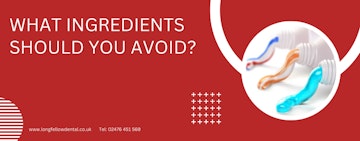
The Best and Worst Toothpaste Ingredients
Toothpaste helps to clean your teeth and freshen your breath. The slightly abrasive substance works with your toothbrush to dislodge food particles, bacteria and sticky plaque from the surface of your teeth. It’s an essential step in your oral health routine. Toothpaste also leaves a minty fresh taste in your mouth and helps to banish bad breath.
You might feel overwhelmed by the choices when it comes to picking your toothpaste. To make it easier to navigate the toothpaste aisle, we’ve put together this short guide to the best and worst toothpaste ingredients. We've also explored some of the "natural" alternatives to toothpaste that you might be considering.

What ingredients should be in toothpaste?
There are many toothpaste products on the market promising many different things, from whitening your teeth to reducing sensitivity. Not many of us spend too long thinking about the ingredients in our toothpaste, instead choosing to focus on the desired results. However, getting clued up on the contents of your toothpaste tube can help you to avoid paying over the odds for something that is unlikely to deliver results.
A good toothpaste should include the following ingredients:
Fluoride – this may also be listed in the ingredients as sodium fluoride and it helps to strengthen tooth enamel and prevent cavities. There have been some unfounded reports that fluoride is bad for you, but this has never been backed up by any evidence.
Potassium nitrate – this ingredient can help to prevent sensitivity by helping to remineralise your teeth and close small channels in the tooth enamel. You will need to use the toothpaste consistently to see results.
Zinc citrate – this is one of the most common ingredients used to remove the buildup of plaque from your teeth. This is the first line of defence against conditions like gum disease.
Calcium carbonate – this is a gentle abrasive agent that can help to remove surface stains from your teeth. If your toothpaste offers natural whitening, it’s likely that this is the ingredient.
Hydrogen peroxide – this is another teeth whitening ingredient, but this one is more potent. This can help to remove surface stains from your teeth, but it can damage your enamel at higher concentrations. This is why any teeth whitening ingredients should be supervised by your dentist.

What ingredients should you avoid?
Now that we know what goes into an effective tube of toothpaste, let’s look at some of the ingredients that you might be best to avoid.
Sodium lauryl sulphate – otherwise known as SLS, this is an ingredient that helps to create a foamy texture when you are brushing. While a foaming toothpaste can help to spread the active ingredients around your teeth more effectively, it can cause mouth sores, redness, swelling and peeling for some people. If you often have mouth irritation after brushing, check to see if your toothpaste contains SLS.
Activated charcoal – this has been a trending ingredient for quite some time and it is promoted as a natural way to whiten your teeth. There is no evidence that charcoal can “absorb” teeth stains, as it is claimed. The substance is also likely to be far too abrasive for your teeth and this could cause irreversible damage to your tooth enamel.

Can you make your own toothpaste?
Some people prefer to make their own toothpaste, but this isn’t advisable unless you know what you are doing. When you make your own toothpaste, you could be missing out on key protective ingredients such as fluoride.
If you are concerned about the contents of your toothpaste and would like some reassurance, we recommend a trip to see your dental hygienist. They can recommend safe and effective toothpaste products and explain the contents to you to put your mind at ease.
What about oil pulling instead of toothpaste?
Oil pulling is often recommended as a natural and holistic alternative to toothpaste and tooth brushing. This method involves putting oil in your mouth and then swishing it, as you would with mouthwash.
We don’t recommend this method as it isn’t as effective at removing plaque and bacteria from your mouth. There is also the risk that you could swallow or inhale the oil, which can be very dangerous. If you would like to explore more natural alternatives to brushing with a mainstream toothpaste, visit the dentist to learn more.

Call us to make your appointment
Interest-free credit available
Worried about the cost of treatment? We offer financing plans to allow you to spread the cost.